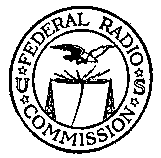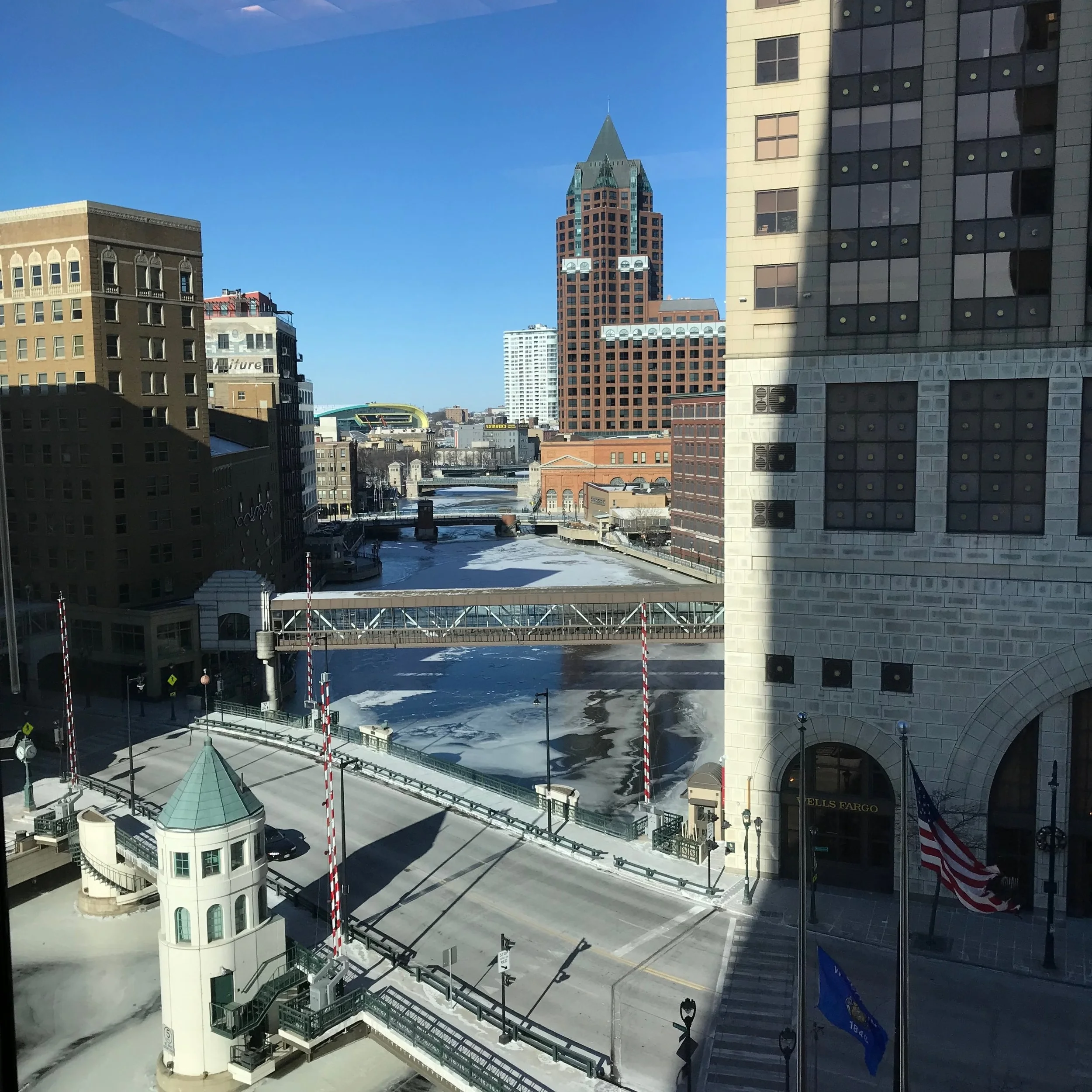WUWM, Milwaukee Public Radio
I hail from a small town. So when I’m In big cities, I spend my time looking up and trying to take in the scale of the buildings that tower into the heavens. In the city centre of Milwaukee, while trying to fight the January cold, I walked up North Water Street and into one of these very structures; a shiny, rectangular, glass-fronted edifice that stands out from the brick building that surrounds it. I took the elevator to the 7th Floor and jumped at the harsh buzz that met me when I pressed the button on the door. I sat in a warm, welcoming waiting room, the walls lined with headshots and posters. On one wall there were glass cabinets displaying some not old but somehow historic pieces of audio equipment. Next to this, a Star Spangled Banner that was complete with a golden Bald Eagle on top that almost touched the ceiling. Above the cabinet was a clear perspex sign emboldened with the letters WUWM, Milwaukee Public Radio.
Headshots of presenters, producers and journalists.
Display cabinet in reception.
I was there to meet Mitch Teich, Executive Producer and Co-Host of Lake Effect, the locally produced mid-morning magazine show on WUWM. Mitch admitted the station's call sign is not the easiest call sign to say; feel free to try it… However, since he’s worked on Lake Effect for 11 years and in Public Radio for a total of 25 years, he can recite it perfectly.
We sat in his office, his desk strewn with notepads, business cards, books yet to be published and personal mementoes. It’s how you’d expect the desk of a producer/journalist to look: lived and worked in, a far cry from modern production offices that are designed for hot-desking and efficiency but lack warmth. This place had warmth, but not literally; it was -14 degrees outside at the time.
I asked about WUWM and Lake Effect. The station is owned by the University of Wisconsin Milwaukee (UWM) and began in the mid-sixties as a student outfit and then joined as a charter member to NPR in the early seventies. It carries major NPR programmes like Morning Edition and All Things Considered with local news and inserts and has a good amount of locally produced shows with both speech and music.
Lake Effect is topical and dips into the issues affecting Milwaukee-ens, politics, culture, interviews and the quirky things that make the city unique. The best example of this is Bubbler Talk, a feature on the show dedicated to answering listeners questions about the local area. Questions like:
How Did Milwaukee Get the Nickname 'Cream City?'
Where Are Milwaukee's Pigeons?
What's That Smell When You Drive Over Milwaukee's Hoan Bridge?
It’s a charming feature that involves the community and taps into the zeitgeist questions locals have been asking for years.
The power of local is often understated, but with the media playing field the way it is, an item in a morning radio show can be turned into content online, putting it in-front of the same potential audience as the ‘big guys.' Mitch has worked in journalism for long enough to have seen big stories come and go, elections, wars, tragedies, but there’s one that stands out for him. The wall next to me had a pinboard attached to it that was festooned with lanyards, badges and press passes dating back to the early days of his career. Taking a prominent, eye level space on the board is a dramatic action shot of a Speedskater on the ice. It’s signed, ‘Mitch, Thank you for giving me a voice, Bridie Farrell.' He had initially set out to interview Bridie for a programme on her career and the Olympics. That interview took place and was aired but off the record at the time she informed Mitch she had another story that needed to be told. Weeks later she sat down with him again for another interview, this discussion was broadcast in-full, unedited and contained the revelation that she had been sexually abused by coach Andy Gabel over a decade previously when she was 15 and he was 33. This was in 2013, a world away from the current climate around sexual misconduct and the ‘Me Too’ movement. The effect of this interview lead to Gabel’s resignation and changes within the sport. You can find the full interview here.
With a handful of broadcast studios and a live session studio used for bands, the station is well equipped for purpose. I was shown around the main broadcast studio used for live news (TOH and Morning Edition) and for playout. There are two record players, a mini-disk player (for archive) and CD players. The microphone of choice is the Shure SM7B Dynamic Vocal Microphone, perfect for speech and has a quiet quality, often attributed to US public radio that Conan O'Brien once quipped was ‘news delivered as if there’s a toddler sleeping in the next room’.
The 'Lake Effect' Studio
Main Brodacst Studio
Lake Effect has its own studio, and when the station moved to its current premises in 2010 the production team got a say in how the studios were designed. They conduct a lot of interviews for the show so wanted a ‘unimposing’ space, not to full of bulky broadcast equipment in order to make contributors more at ease than they would be if they were on the deck of Starship Enterprise FM, a look that a lot of radio nerds like myself tend to enjoy.
Radio broadcasting evolved very differently in the US compared to the UK and Publicly owned airwaves were not the norm when national broadcasting began. In the UK, the BBC lead the way in programming and development then over time commercial radio picked up and the playing field was made even. The US doesn't have a national broadcaster; broadcasting is governed by a federal body, the FCC (Federal Communication Commission) formally FRC (Federal Radio Commission) but there is no broadcaster fully funded by the government. Public Radio is the closest thing to the BBC the states has and it began on a local stage. Public stations exist all over the country, there are over 1,400 of them and they’re usually funded privately by university’s, foundations or public authorities as well as donations from the public and underwriting. 900 of these stations are ‘affiliates' of NPR and, like WUWM, they carry NPR shows as well as producing local news/ programming. This combined army of stations and the single brand power NPR has makes both, among the most trusted on the dial for the quality of programming and journalism.
One corner of the office has 'The nicest view in the city'
The way we make radio and what we make has changed. Radio producers are rarely confined to the walls of one programme or one platform, as well as his duties as an exec producer Mitch also produces The Pretzel Podcast, you read that right. A podcast dedicated to the dippable treat that originated after a conversation with a colleague where they discover they both had strong opinions about the foodstuff. Yes, it’s odd, but some of the best ideas are and while he told me about the idea, I started telling him my thoughts on pretzels and we got into a deep discussion about twisted bread. Baked knot’s aside, the Podcast is not broadcast on the station, it's purely a stand-alone downloadable project and its a great thing for the station to have, even if it isn’t the next Serial, its another creative outlet for producers to have ideas, and if you keep your staff on there creative toes, that can only be a good thing for the station overall. Also, the best pretzels don’t have salt on them.. just saying.
My time at WUWM was indicative of my time in Wisconsin as a whole; a welcoming, kind atmosphere that has a unique identity. They understand and care about the local community, and that’s why public radio is as important as it’s ever been. In a time where facts are less fruitful than they used to be, strong, independent, local programming and journalism can lead by example, holding feet to fire and pretzels to dip’s.






















What day is it? Who are you?